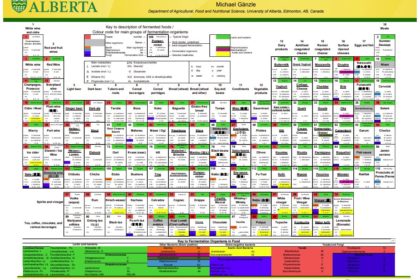
A pioneering “periodic table” of fermented foods was released this month, the first attempt to represent the breadth and range of fermented foods and beverages in graphic form.
This creation is the brainchild of Michael Gänzle, PhD, professor and Canada Research Chair in Food Microbiology and Probiotics at the University of Alberta. Gänzle is regarded as an expert in fermented foods and lactic acid bacteria. His recent research includes identifying a new taxonomy for the lactobacillus genus, a topic Gänzle spoke about in a TFA webinar.
“Non-traditional fermented foods are a big trend both in industrial food production and in culinary arts,” Gänzle said in an interview with TFA. “The periodic table may be the most concise overview on what is possible if all of the diversity of our benign and beneficial microbial helpers is recruited.”
The impetus for the table dates to 2014, when Gänzle and a colleague used a periodic table of beer styles in their food fermentation class. They wondered if it would be feasible to create a similar version for fermented foods.
Gänzle’s final version, along with his well-documented analysis of the table, was published in the journal Applied Microbiology and Biotechnology. The table includes 118 entries of fermented foods, each coded for product category, country of origin, fermentation organism (like LAB, acetic acid bacteria or yeasts), fermentation substrate, metabolites and fermentation time.
Gänzle suggests the table is “quite useful for a number of things that may impact the development of fermented foods.” He says fermentation has “reemerged as a method to provide high-quality food.” A chef or producer can use the table to compare “differences and similarities in the assembly of microbial communities in different fermentations, differences in the global preferences for food fermentation, the link between microbial diversity, fermentation time and product properties, and opportunities of using traditional food fermentations as templates for development of new products.”
Because of its straightforward graphical layout, the table can quickly answer questions. A scan of it shows “which foods contain live fermentation microbes, which regions of the world have which preferences for substrates and fermented foods, which fermented foods are back-slopped and are fermented with host-adapted fermentation organisms.”
He stresses, though, that the table has its limitations, as it doesn’t cover every fermented food.
“The more I read the more likely I am to quote Plato’s rendition of Socrates’ statement that ‘I neither know nor think I know,’” Gänzle says. “Fermented foods are about as diverse as humankind.”
Gänzle plans to continue to revise the table on his personal website. Currently, he and two doctoral students are researching fermented soy and legumes, so look for the next updates to be in those categories.
